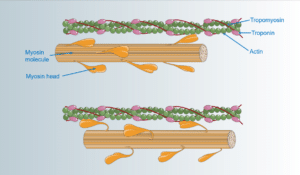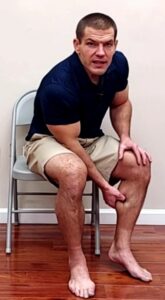Do You Get Muscle Knots In Your Legs?
If you get knots in your quadriceps, hamstrings, or calves and you'd like to learn how to relieve them, make sure to watch this video. You'll learn 5 ways to release muscle knots in your legs, plus one thing NOT to do.
Table of Contents
- What NOT To Do For Knots In Your Legs
- 5 Ways To Release Muscle Knots In Legs
- Releasing Muscle Knots With A Foam Roller
- Releasing Knots In Legs Using A Muscle Massage Stick
- Releasing Muscle Knots In Legs Using A Massage Gun
- Manual Trigger Point Release For Knots In Legs
- Dry Needling To Release Muscle Knots In Legs
- When To Stretch Knotted Muscles
- Need Help For Muscle Knots In Your Legs?
What NOT To Do For Knots In Your Legs
Before we get started into the five things to do, I want to start out with the one thing NOT to do.
One thing that you do not want to do for knots in your legs is to stretch them.
Now, it's not that stretching is bad.
However, stretching is not a good solution for knots in your legs.
The reason for that is that your muscles aren't just like rubber bands
Muscles are made up of overlapping fibers back to back to back called sarcomeres.
The Structure of a Sarcomere. Credit: Open Learning Initiative, CC BY-NC-SA.
The filaments in sarcomeres are called actin and myosin.
When you get knots in your legs, the actin and myosin fibers get stuck together and won't let go.
When some sarcomeres get knotted or bound, the rest of the sarcomeres in the muscle may still work ok.
Therefore, when you stretch, the sarcomeres that already move ok are the ones that get stretched. However, the stiff, knotted sarcomeres stay stiff and knotted.
Stretching sensitizes the muscle spindle
Furthermore, when you stretch a muscle, it sensitizes a receptor in the muscle called the muscle spindle.
That's what activates when you do the knee-jerk reflex when you go to the doctor and they hit your knee with a hammer.
When you stretch a muscle that's knotted, it sensitizes that muscle spindle and tells the muscle to actually contract or tighten up more.
That's why stretching is not a good solution for knots.
So what should you do instead?
5 Ways To Release Muscle Knots In Legs
These are the 5 ways to release muscle knots in legs.
The more specific the technique, usually the more effective it is.
I'll start with the most general solution and progress to the most specific solution.
Releasing Muscle Knots With A Foam Roller
The first solution is using a foam roller.
This is a pretty common thing that people do for knots in their legs, but there are a couple of drawbacks.
Mostly, these are good for larger muscles.
Therefore, using them on your quadriceps or hamstrings is good.
However, it's a little bit harder to use on your calves because your body weight is behind the foam roller, not over top of it.
Therefore, you really don't get great pressure on the calves.
For that reason, it's probably better to use the foam roller for knots in your hamstrings or in your quadriceps.
ProsourceFit High Density Foam Rollers 3...
14% OffThere are some drawbacks to that as well though.
It's kind of uncomfortable and if you have trouble getting on and off the floor, using a foam roller may not be for you.
Furthermore, it's a large diameter roll, so you can't be very specific with it.
So next I'll show you another more pinpoint solution.
Releasing Knots In Legs Using A Muscle Massage Stick
You can use a regular baking rolling pin or a muscle massage stick.
Idson Muscle Roller Stick for Athletes- ...
$9.15 (as of July 26, 2024 17:22 GMT -05:00 - More infoProduct prices and availability are accurate as of the date/time indicated and are subject to change. Any price and availability information displayed on [relevant Amazon Site(s), as applicable] at the time of purchase will apply to the purchase of this product.)These muscle massage sticks have a much smaller diameter than a roam roller.
Therefore, you can be a little more specific and find the individual areas where you have knots in your legs.
You can use this pretty much on any muscle group, whether it be your quadriceps or your hamstrings.
However, it's also a better than a foam roller for smaller muscle groups like your calves.
Releasing Muscle Knots In Legs Using A Massage Gun
You can use a massage gun. When you use a massage gun, it uses vibration to help calm down your muscles and make them relax.
Auto Amazon Links: No products found. (1 items filtered out)
When you use a big head it vibrates your muscles and the nerves that pick up vibration.
They're large, fast-conducting nerves, so they send that vibration signal to your spinal cord and then up to your brain.
That signal reaches your brain before painful signals, which travel along smaller, less fast nerves.
Because that vibration sense gets there sooner, it blocks the painful sensation, and it actually makes your muscle relax.
Now, you can get a little bit more specific by using a smaller head.
A smaller head provides a little bit more pinpoint treatment to individual knots or trigger points.
Manual Trigger Point Release For Knots In Legs
If you want to get a little bit more specific yet, you can do manual trigger point therapy use your hands.
When you're using a massage gun, you get one-way feedback.
You can feel the sore area in your leg, but you can't feel very well through the gun.
If you want to get two-way perception, then you use your hand so that you can feel it on the leg and also feel it through your fingers.
This technique is particularly helpful for knots in your calves. You can do it anywhere though.
Just roll along the muscle and find an area where it feels like there's a knot or a taut band.
Once you find that area, hone in to where that tight area is and then apply a gentle pressure.
Hold the pressure for 1-2 minutes to get the muscle to relax.
You want the muscle to be in a relaxed position when you're doing the treatment.
So if you're doing it on your quadricep, it helps to have your legs straight so that the quadricep isn't stretched over your knee.
If you're treating your calf, you want your toes slightly pointed.
When treating your calves, pinch the muscle between your fingers.
Then hold 1-2 minutes.
Dry Needling To Release Muscle Knots In Legs
Finally, if you want to get a little bit more specific yet, you can go to a physical therapist and get a treatment called dry needling, where your therapist puts an acupuncture needle inside the muscle knot.
However, although dry needling uses acupuncture needles, it's quite different from acupuncture.
You can learn more about dry needling in the guide below.

When you're doing just a manual trigger point release as shown above, you're pressing right on the trigger point. However, you're still outside the skin.
With dry needling, the needle actually goes inside the trigger point and deactivates it neurologically.
Dry needling can be slightly painful, but it's extremely helpful for chronic muscle knots that won't go away with other treatments.
If you're in the St. Louis area, you can request a dry needling appointment here.
When To Stretch Knotted Muscles
After you've done one of the techniques above to release the muscle knots in your legs, THEN it's time to stretch them.
Take advantage of the improved flexibility in the muscle, and stretch the muscle after the knots are released.
This will help prevent the muscle knots from coming back.
Need Help For Muscle Knots In Your Legs?
Now, if you live in the St. Louis area and need help for muscle knots, we'd be happy to help you here at More 4 Life.
Just tap the button below to request an appointment with one of our specialist physical therapists.














